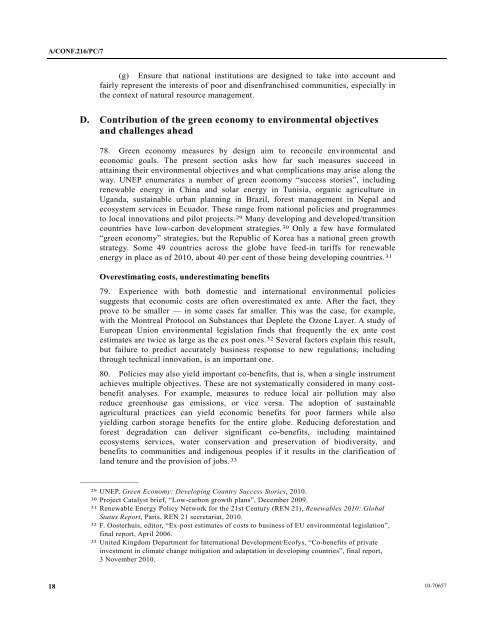General Assembly - UN Documents
General Assembly - UN Documents
General Assembly - UN Documents
Create successful ePaper yourself
Turn your PDF publications into a flip-book with our unique Google optimized e-Paper software.
A/CONF.216/PC/7<br />
(g) Ensure that national institutions are designed to take into account and<br />
fairly represent the interests of poor and disenfranchised communities, especially in<br />
the context of natural resource management.<br />
D. Contribution of the green economy to environmental objectives<br />
and challenges ahead<br />
78. Green economy measures by design aim to reconcile environmental and<br />
economic goals. The present section asks how far such measures succeed in<br />
attaining their environmental objectives and what complications may arise along the<br />
way. <strong>UN</strong>EP enumerates a number of green economy “success stories”, including<br />
renewable energy in China and solar energy in Tunisia, organic agriculture in<br />
Uganda, sustainable urban planning in Brazil, forest management in Nepal and<br />
ecosystem services in Ecuador. These range from national policies and programmes<br />
to local innovations and pilot projects. 29 Many developing and developed/transition<br />
countries have low-carbon development strategies. 30 Only a few have formulated<br />
“green economy” strategies, but the Republic of Korea has a national green growth<br />
strategy. Some 49 countries across the globe have feed-in tariffs for renewable<br />
energy in place as of 2010, about 40 per cent of those being developing countries. 31<br />
Overestimating costs, underestimating benefits<br />
79. Experience with both domestic and international environmental policies<br />
suggests that economic costs are often overestimated ex ante. After the fact, they<br />
prove to be smaller — in some cases far smaller. This was the case, for example,<br />
with the Montreal Protocol on Substances that Deplete the Ozone Layer. A study of<br />
European Union environmental legislation finds that frequently the ex ante cost<br />
estimates are twice as large as the ex post ones. 32 Several factors explain this result,<br />
but failure to predict accurately business response to new regulations, including<br />
through technical innovation, is an important one.<br />
80. Policies may also yield important co-benefits, that is, when a single instrument<br />
achieves multiple objectives. These are not systematically considered in many costbenefit<br />
analyses. For example, measures to reduce local air pollution may also<br />
reduce greenhouse gas emissions, or vice versa. The adoption of sustainable<br />
agricultural practices can yield economic benefits for poor farmers while also<br />
yielding carbon storage benefits for the entire globe. Reducing deforestation and<br />
forest degradation can deliver significant co-benefits, including maintained<br />
ecosystems services, water conservation and preservation of biodiversity, and<br />
benefits to communities and indigenous peoples if it results in the clarification of<br />
land tenure and the provision of jobs. 33<br />
__________________<br />
29 <strong>UN</strong>EP, Green Economy: Developing Country Success Stories, 2010.<br />
30 Project Catalyst brief, “Low-carbon growth plans”, December 2009.<br />
31 Renewable Energy Policy Network for the 21st Century (REN 21), Renewables 2010: Global<br />
Status Report, Paris, REN 21 secretariat, 2010.<br />
32 F. Oosterhuis, editor, “Ex-post estimates of costs to business of EU environmental legislation”,<br />
final report, April 2006.<br />
33 United Kingdom Department for International Development/Ecofys, “Co-benefits of private<br />
investment in climate change mitigation and adaptation in developing countries”, final report,<br />
3 November 2010.<br />
18<br />
10-70657




